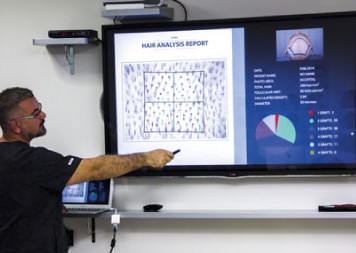Fue Hair Transplant Review
Techniques for hair restoration surgery include scalp reduction surgery, strip harvesting (FUT), and follicular unit extraction (FUE).
FUE hair transplant procedures can be divided into 3 steps: extraction, creation of recipient incisions and implantation of follicular grafts.
Follicular unit extraction (FUE)
FUE is a method of graft harvest that is used in FUE hair transplants. It is the latest major technical advancement in hair restoration surgery.
In an FUE hair transplant, a large number of hair follicles is obtained in a single day providing excellent regrowth and patient tolerance without any great scarring.
Each individual follicular unit (FU) is obtained directly from the scalp, rather than from a strip of donor tissue that has been removed from the scalp.
FUE hair transplants were originally performed using manually hand-held punches of various types and are still used to remove follicular units one at a time.
In general, any patient who is a candidate for hair restoration surgery is a candidate for FUE hair transplant. A patient may be a poor candidate for a strip harvest, yet may achieve a good result with FUE.
Fue Hair Transplant Results
An FUE hair transplant provides;
- shaving the head without any noticeable scarring (to wear hair <2 mm.)
- no sutures, no permanent linear scar
- decreased healing time, comfortable healing process
- less post-operative pain
- fewer limits on post-op activity
- viable alternative in people with very tight scalps
- extends the donor area
- useful if limited number of grafts are needed
- ideal to repair donor scar
- operation in low-density donor hair,
- debulking plugs and minigrafts
- removal of undesirable hairline grafts
- body hair harvest
- no permanently distortion of hair growth angles
FUE requires a steep learning curve, patience, physical stamina and endurance, a delicate touch, excellent hand–eye coordination and excellent hand motor skills.
An FUE hair transplant can be done well or badly just as any other form of surgery.
Manual FUE Method
Essentially, it can be said that manual FUE hair transplants protect the donor area and provide good quality grafts.
At Asmed, we implement our original technique, the sequential (DES) technique while performing FUE hair transplants.
The goal of an FUE hair transplant is to achieve homogenization throughout the head. To provide homogenization, it is important to use all parts of the donor area in random distribution. Even after multiple sessions, the donor area appears to be slightly less dense than it was previously, but only upon close inspection.
The skull normally comes in different contours and shapes, creating a constant change in the direction and angle of the hair. With magnification and tactile sensation, one can visually and mentally process the subtle nuances of the skin and hair characteristics, and then extract the follicular unit with precision. According to the extracted follicle parameters, any situation can be adjusted in adequate time. This important step is omitted without immediate feedback potential.
With the Manual FUE technique, the donor area is maximized efficiently and conservatively, enabling the potential for future hair transplant procedures for the patient.
With the Manual FUE method, the patient's donor area is utilized as needed.

Megasessions
FUE hair transplant megasessions refers to transplanting a large number of grafts in a single session. At Asmed, we implement megasessions with great success.
The advantages of a megasession are; a faster end result and the convenience of having an FUE hair transplant in a single session rather than over several sessions.
The success of the FUE hair transplant requires mastery using micro-sized openings and special implanting techniques with high-powered magnification. Patients must be carefully selected . An experienced, well-organized FUE hair transplant surgical team and quality control is mandatory.
Lateral slit (coronal, perpendicular)
The incisions give the hair growth direction, angle, spacing, and depth so that the FUE hair transplant surgeon can sculpture and create a natural-looking.
Slit orientation for FUE hair transplants can be parallel or lateral. Incisions made perpendicular to the direction of hair growth are called lateral slits. Those made in a parallel direction are referred to as parallel (sagittal) slits.
The lateral technique reproduces better scalp anatomy. Natural hair varies from 10° to 90°. The lateral incision allows for precise control of graft angulation. Producing more acute angles also has the benefit of increasing coverage. By using smaller incisions we can produce greater densities.
Lateral orientation
- causes less tissue damage
- permits closer graft placement
- makes hair strands shingle
- creates the illusion of more volume